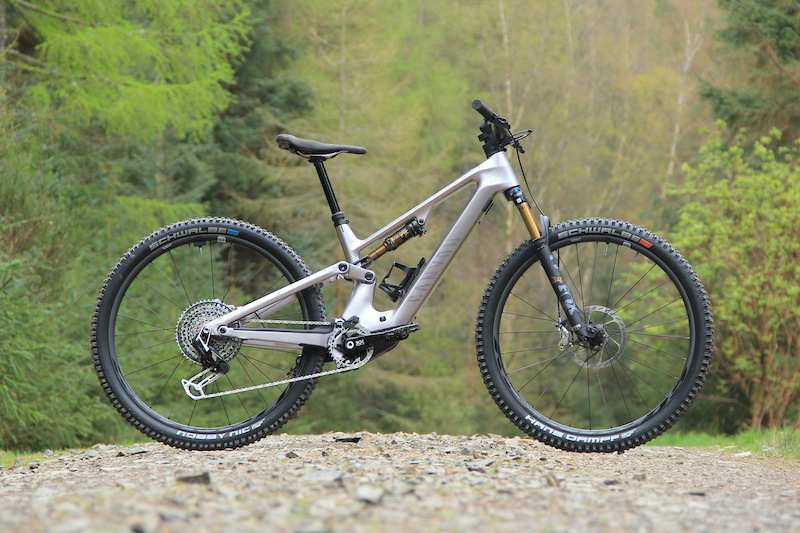Canyon aren’t erasing the Neuron:ON. It remains in the range as the heavier, higher capacity, torquier option. The Neuron:ONfly is another kettle of fish entirely, and judging by the geometry overhaul, a much better one at that. Motor and battery capacity preferences aside, the Neuron:ONfly should be a far more capable descender for all riders, not least because long travel dropper seat posts are now very much on the table.
• Carbon frame
• Travel: 140mm f & r (130mm in XS)
• 29″ Wheels
• 64.5° Head Angle
• Reach: 410, 435, 460, 485, 510mm
• Chainstay length: 450mm
• Bosch SX Motor
• 400 Wh (250 Wh range extender)
• Maximum system weight limit: 130 kg
• Weight: 18.54 kg / 41 lbs (CF LTD, S)
• Price: €7,999 (CF LTD)
• 2 Year Warranty
• canyon.com
The Neuron:ONfly also serves more riders, with five sizes spanning a height range of 158cm to 200cm. The S-XL bikes boast 140mm front and rear wheel travel, while the XS is a little short-changed at just 130mm due to packaging constraints. All run dual 29″ wheels.
One of the most impressive things about the Neuron:ONfly is its price. The entry-level CF7 comes in at an astonishing $5,499 USD / €4,849. Complete with a Rockshox Deluxe Select+ shock and Rockshox Pike Base fork, SRAM Code R four piston brakes, and a Shimano Deore 12 speed drivetrain, it is surely one of the best value eMTBs that money can buy. I got a short ride on the the top-end CF LTD model, first impressions of which are below.
Frame Details & Motor
The Neuron:ONfly gets a carbon frame, with the System Controller embedded into the top tube. The frame is packaged to allow for the use of the 250 Wh PowerMore range extender, or a water bottle – you can’t have both. With the 400 Wh internal battery, maximum capacity is a respectable 650 Wh.
As is the case on most SL eBikes, the main battery is not designed to be user-removable for charging off the bike. While some may prefer to remove the battery for charging, the unseen advantage to such a design is that it’s much easier for the frame engineers to make a much stiffer front triangle when they can work with a completely closed downtube. The risk of dropping a battery while riding is also eliminated.
On the Neuron ON:fly CF LTD I’m testing, the SRAM XX Transmission derailleur is wired into the system, so there is no removable AXS battery to remember to charge. If you empty the tank on a ride, the system should ring-fence some battery life so that the derailleur can still perform around 600 shifts (ours ceased to function, however). If the connection breaks in a crash, you can always disconnect the extension wire and replace it with a regular AXS battery.
The sensor for the Bosch SX motor is contained to the valve stem, and the wireless Mini Remote on the handlebar is used to switch between modes. Though Bosch does offer a number of display unit options, Canyon has opted to go without, keeping the cockpit clutter-free. Those who want to see all their data can simply connect their Garmin, phone or other device to the Bosch Smart System.
Canyon continue with the familiar four-bar layout that’s seen on the longer travel Spectral:ON and Torque:ON models, but the layout and seat tube girth has been mindfully tweaked to result in a massive increase in seat post insertion depth. The result is that all of the frame sizes can now accommodate a much longer travel dropper seat post as compared to the equivalent Neuron:ON frame, something that stands to be nothing short of transformative in how competently one can ride it downhill. The XS gets a 150mm post, the S a 170mm, the M & L a 200mm, while the XL gets a 230mm.
In line with those longer posts, Canyon has increased the seat post diameter to 34.9mm where an improvement in stiffness stands to benefit the longevity of the post’s internals. All Neuron:ONfly models get a proprietary seat post from Canyon that is travel adjustable in 5mm increments, down as much as 25mm from the numbers stated above.
Frame protection is somewhat considered, with good coverage along the chainstay and seat stay, though the lower link goes without the protection conferred to the other models in the ON range. The gap between the stay and the seat tube is larger on this model though, which Canyon say reduces the risk of damage from stones. The downtube is also devoid of any impact protection, though there is a strip of transparent frame wrap on there that will preserve the paint finish.
The downtube has a single set of bottle bosses for the mounting of a bottle cage of your choice. However, the bike ships with an adapter that serves to house the range extender, or Canyon’s own cage. I wouldn’t recommend the latter as it rattles loudly when loaded with a full bottle. A short cable cable connects the additional battery to the system via the charging port on the non-drive side.
When the range extender is not in use, a flimsy unsealed spring-backed flap covers the port, held in place by a small magnet. When the range extender is connected, this flap sticks out. It’s rather vulnerable to getting snapped off if caught by the rider’s heel if they ever pedal with their foot slightly off axis. To my mind, it’s a case of not if, but when.
Geometry
While the Neuron:ONfly is only 5mm longer in reach than the non-motorized Neuron CF, it is considerably longer overall owing to its much slacker 64.5° head tube angle and longer 450mm chainstay. The wheelbase of a size large is 1271mm with a reach of 485mm. Seat tube length across the size range has been reduced significantly, now at just 445mm on the large – a change that contributes to the frames now being amenable to longer travel dropper posts.
No aspect of the bike’s geometry is adjustable, so there is no scope to deviate from that 64.5° head angle, 76.5° effective seat tube angle and 340mm BB height. For those wondering; no, Canyon does not approve use of a 150mm travel fork, and have confirmed this would void the warranty.
That 450mm chainstay length is consistent across the XS-XL size range. So, while the reach increases by 24% from XS to XL, the rear-center length remains the same, something that will give bikes at opposite ends of the range a meaningful difference in front-to-rear balance. Of course, this is the case for most brands that do not take a more proportional approach to geometry design, but I will say that the 450mm chainstay length on the XS with its 410mm reach is quite extreme by most standards. From a resource standpoint, the Canyon engineers did not have the option to tune chainstay length across the sizes.
Canyon are using 170mm cranks across the board, with a 34T chainring on S-XL, and a 32T chainring on the XS. They say the feedback from test riders was that 170mm cranks felt good, but they also said they will consider choosing 165mm cranks for any future models, and perhaps using that smaller 32T chainring for all sizes.
The cockpit components are all own-brand, with a 45mm stem paired with a 20mm rise aluminum bar for all sizes. Only width is adjusted; 740mm for XS, 760mm for S & M, 780mm for L and 800mm for the XL.
Suspension
The Neuron:ONfly delivers its rear wheel travel via a familiar Horst-link suspension platform that Canyon use on all of their trail bikes. On the S-XL frames a standard in-line 210mm x 55mm shock damps rear wheel displacement to give an average leverage ratio of 2.54. Meanwhile, a 210mm x 50mm shock on the XS gives that linkage a lower average leverage ratio of 2.36 over its 130mm travel. Either way, progression is smooth throughout the travel, and at no point does it become regressive.
The XS has a different shock altogether as compared to the shock on the S-XL. It is not simply a 55mm stroke shock with a stroke limiter inside it. This one has a distinct damper tune, which is said to better cater to the lighter riders (60-68 kgs) it is likely destined for. Meanwhile, the very same shock damper tune is implemented across the S-XL frames.
Anti-squat, the term used to describe how much a bike’s linkage is able to resist compression under pedal-induced acceleration, is higher for the Neuron:ONfly than it is for the torquier Neuron:ON. That’s true right through the full travel, and across the full range of the cassette. Theoretically, this should mean the Neuron:ONfly will remain higher in its travel under pedal-induced accelerations, keeping the frame’s geometry just that little bit steeper and more upright, something that should be beneficial for riding up steep inclines.
Product Manager, Bastian Langlitz, says this was intentional. With the higher cadence encouraged by the Bosch SX motor versus the CX motor, the engineering team wanted to make the suspension on the ONfly model feel more efficient under pedaling.
Models
The Canyon Neuron:ONfly is available in four models, though the CF7 is the only model that will be available in the US. Pricing below does not include the range extender, which costs an additional €469.95 / £439.95 / $505 USD.
First Ride Impressions
At 163 cm tall, I tested the Neuron:ONfly CF LTD in a size small. With its 400 Wh battery and a tubeless setup, it weighs 18.54 kg (41 lbs). With the 250 Wh range extender it weighs 20.1 kg (44 lbs). While that is reasonably light, I can’t say I’m blown away by those numbers. I recently rode a more capable 150/160mm travel eMTB with a larger 420 Wh battery, alloy wheels and heavier casing tires, and it weighed 19 kg.
The Canyon is home to carbon wheels in the form of Reynolds Blacklabel Trail Expert 329 rims laced to a Ringle hubset, with a 29″ x 2.4″ Schwalbe Hans Dampf Soft on the front, and a 29″ x 2.4″ Schwalbe Nobby Nic SpeedGrip on the rear. Then, there’s the SRAM XX Transmission 12-Speed drivetrain and SRAM Code RSC brakes with a 200mm HS2 rotor front and rear. Up front we have a Fox 34 Factory fork with the FIT4 damper, paired with a 210mm x 55mm Fox Float Factory shock.
Despite having a modest 55 Nm torque and a sub 2kg weight, The Bosch SX motor actually has the capacity to deliver the same 600 W peak power of the meatier 85 Nm CX motor. However, you have to pedal faster to convince it to give you that. While the 2.9 kg CX motor will give you 600 W at a cadence of just 70 rpm, the Bosch SX asks you to spin at 100 rpm before it will dish out the big watts.
Thanks to its greater power, the Bosch SX motor will outcompete similarly lightweight mid-torque motors like the TQ-HPR50, especially on steep technical sections that require a significant injection of assistance. That said, it does come at the cost of an easily audible whine. It also has the added benefit of the Extended Boost feature, wherein the motor continues to deliver power to the rear wheel up to 2 meters after its rider has stopped pedaling. There are four riding modes; Eco, Tour, eMTB and Turbo, all of which are tunable in terms of the level of assistance they provide. Only the eMTB and Turbo modes deliver the Extended Boost. There’s also a Walk mode that can be activated by holding the down button on the remote for several seconds.
At a regular cadence of 70 rpm, what you might spin at up a fire road, you get just 400 W, which feels nicely supportive. It feels quite unnatural for me to pedal any faster than that over a sustained period of time, but it was good to have the extra power there in reserve when riding steeper, more technical terrain. When you need to throw in a couple of really quick pedal strokes to clean a steep section, the extra power is there in reserve as your cadence naturally increases in those types of riding situations.
It wasn’t always easy to control, however. On occasion, the extra injection of power would feel quite surprising and send me off balance a little. I also noted that the grip offered by the Schwalbe Nobby Nic with the SpeedGrip compound was lacking. It struggled to maintain traction with the additional torque, even on dry roots and rocks, and I found I was consistently spinning out. The experience was improved by dropping the motor mode down into Tour, but even then the tire wasn’t able to maintain a consistent grip with the terrain. To my mind, Canyon would do better to spec the Addix Soft version of the Nobby Nic. With the motor there to help you ride up sections you might not usually consider attempting, a relatively low grip tire in the rear only does the bike a disservice.
As for range, I got 27.26 km and 1,093 meters gained out of the 400 Wh battery on a full charge. I spent 95% of the time in Turbo. At empty, power to the derailleur was also lost. As mentioned earlier, the intention is that the Bosch system preserves sufficient battery life for a further 600 shifts of the derailleur. We await comment from Canyon as to why this was not the case on our test bike.
The trails have finally properly dried out for the very first time in 2024, and it’s verging on dusty with the appearance of some loose gravel in turns. I initially set up the bike with 30% sag in the rear, and the Fox recommendation of 68.5 PSI in the fork. On each, I turned the compression and rebound dials to the open position. I went with 18 psi in the front tire, and 21 psi in the rear. I also cut the bar down to my preferred 740mm.
I wasn’t overly impressed with the bike’s descending performance on this first ride, though there is still scope for improving the setup. It handles OK in turns, but it doesn’t seem to carry its weight in quite such a spritely manner as some of the slightly longer travel eMTBs I have tested recently. The fit feels good for the most part; a 435mm reach is pretty spot on for me, and the 170mm dropper gets the saddle comfortably out of my way. There was an appreciable benefit to lowering the stem by 10mm, which helped me weight the front wheel more assertively. Thereafter, I was able to ride the bike quite confidently on the less technically demanding trails with little gradient, but some flaws in the suspension setup made life difficult elsewhere.
Both the fork and the shock will benefit from additional volume spacers to give more support to the end-stroke. As is, full travel is reached too easily, and I ended up running more air in both, winding on some low speed compression damping for the fork to help it stay up in its travel. I felt the rear benefited from running reduced sag of around 27%. With the more standard 30% sag, things became quite harsh over sustained rough sections of trail, as though the shock wasn’t able to recover fast enough from successive hits.
On one of the more mellow, flow trails, I played around with the shock’s middle compression setting and found that it offered a more supportive feel through berms, giving a very positive platform to push against. Later in the ride, it became clear that the lightest compression setting (position 1) is the only viable option when the trail gets steeper and choppier.

Laura Adams is a tech enthusiast residing in the UK. Her articles cover the latest technological innovations, from AI to consumer gadgets, providing readers with a glimpse into the future of technology.








